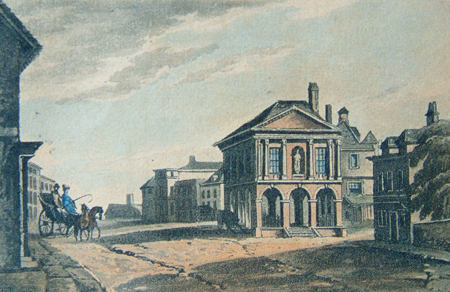 |
Strictly speaking, Windsor's famous Guildhall,
should be known as the Town Hall, for it was never the meeting
place of the town's guilds. The meeting place or 'Guild Hall'
would have been the 'Three Tuns' next door, which dates from
around 1518. 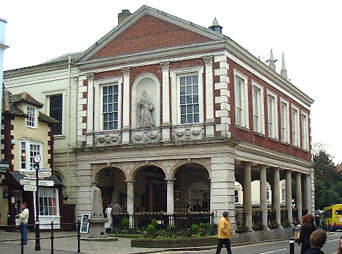 and Queen Anne in the central niche By 1337 we have the first recorded name
of the steward, or leader, of the Guildhall, John Godray. Within
a few years, in 1363, the title steward had given way to mayor,
the first recorded being John Peyntour, whose position required
him to represent the town, and exercise jurisdiction in a court
that was held every three weeks. In 1439 a second charter was
granted that included the right for the mayor and bailiffs to
be Justices of the Peace and the title 'steward' fell out of
use. A further Royal Charter of 1466 established a new Corporation
comprising the mayor, bailiffs and burgesses. 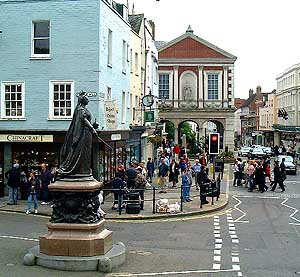 In 1592 a new market house was built just to the north of the site of the present Guildhall. This building lasted rather less than 100 years for in 1687 the council ordered it to be demolished. It was illustrated below by John Norden in his map of Windsor dated 1607. This is believed to be the only picture of this particular building. Note the pillory towards the church. 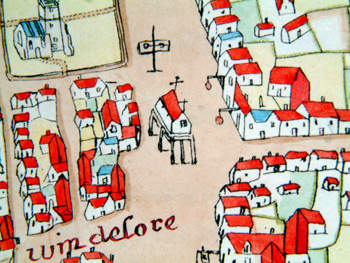 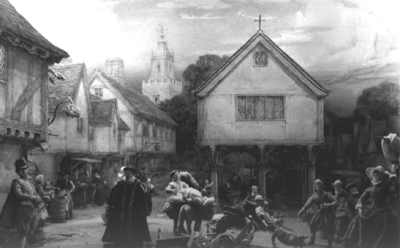
The Town Hall as we know it today was commenced in 1687, the foundation stone being laid on 5th September 1687. It was designed by Sir Thomas Fitz, (Fiddes), Surveyor to the Cinque Ports. Sir Thomas died before the work was finished, and it was completed by Sir Christopher Wren and ready for occupation on 17th October 1689. The design of the building allowed for a corn market beneath the meeting chamber above. Many have wondered about the four pillars in the centre of the Corn Market, for they do not actually support the ceiling. Rumour has it that the council were concerned that the unsupported floor of the chamber may collapse, but Sir Christopher Wren, to prove a point, left the additional columns short of the ceiling. The pillars are of Portland Stone. In the large council chamber are a number of excellent paintings of Royal and other persons, including portraits of King George V and Queen Mary, presented by Their Majesties to the Corporation. 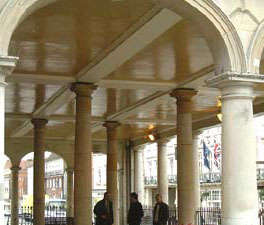
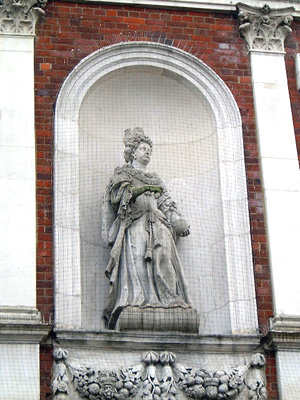
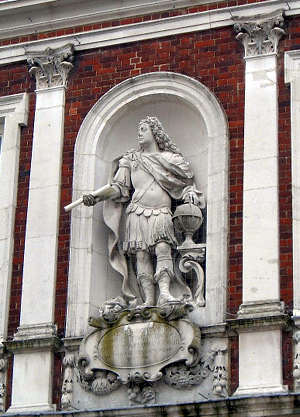
The Town Hall until a few years ago was stuccoed and painted. The stucco has now been removed, the old walls beneath re-exposed and the building restored to its original appearance. 1969. A 'Near Miss' for the Queen forces Guildhall RestorationDuring the autumn of 1969
Her Majesty the Queen paid a visit to the Guildhall at Windsor.
What has remained unreported until now is that the very next
day a length of heavy plaster frieze rail fell from high up in
the Committee Room. It was realised with horror that Her Majesty
had passed below that point only a few hours before! There were
cracks appearing in the pediment mouldings, and the matter was
debated urgently at the next committee. The Borough Engineer
had scaffolding erected at the east end, to examine the brickwork,
which appeared to be suspect. The officers were appalled to find
that the whole pediment could be moved and so the area was closed.
A consultant architect [Messrs Donald Insall & Associates]
was engaged as a matter of urgency and their comprehensive report
was submitted in November 1969.
|
The Guildhall, which is situated in the principal part of the town, was erected in the year 1686, from a design by Sir Thomas Fiddes, Surveyor of the Cinque Ports, at the expense of £2006.14s. and was paid by the Corporation, except the sum of £680.7s.6d. which was presented by several gentlemen. This is a handsome structure, supported with columns and arches of Portland stone. The hall or room in which the corporation meet for the dispatch of the business of the borough, is spacious, and well adapted for the purpose; and was in 1787, greatly improved by altering the construction of the windows, and substituting modern sashes in lieu of common quarries. It is adorned with the portraits of James I, Charles I, Charles II, James II, William III, Queen Mary, Queen Anne, George, Prince of Denmark, Prince Rupert, Archbishop Laud, Theodore Randue, Esq., The Earl of Nottingham, Lord Admiral in the year 1688, Governor of Windsor Castle, and High Steward of the Borough, etc. In 1707, the Corporation, from their regard to Queen Anne, who constantly resided at Windsor during the summer season, erected in a niche at the north end of this structure, the statue of that princess, vested in her royal robes, with the globe sceptre in her hands. Underneath, in the frieze of the entablature, is the following inscription in letters of gold.
And in a niche on the south side, is the statue of Her Majesty's royal consort, Prince George of Denmark, in a Roman military habit. Underneath is the following inscription:
In English thus: an hero to be revered in every age. Christopher Wren, Esq. erected this statue, 1713. In the area under the hall, is kept a market on Saturdays; and three fairs, on Easter Tuesday, July 5th and October 24th. These are become very inconsiderable, since their Majesties have resided so much here; who by their benevolent diffusion of their favours have excited a spirit of industry and emulation in the different tradesmen, who vie with each other in the improvement of their shops, and in the quality and cheapness of their various commodities; so that most of the necessaries, with many of the superfluities of life, may be purchased here on as eligible terms as at the first shops in the metropolis. |
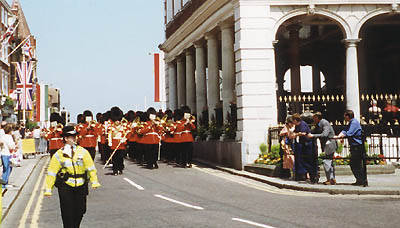
The former Corn Exchange of the Guildhall makes an excellent viewing platform as the Guard and Band march to and from the castle for the Changing of the Guard ceremony.
The Guildhall
is available for hire for events and celebrations of all kinds.
Please see
RBWM Web Page
See also
|
See also |
Back
to Royal Windsor Home Page
To contact us, email Thamesweb.
